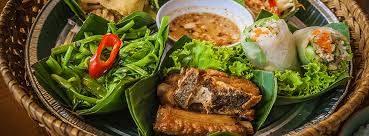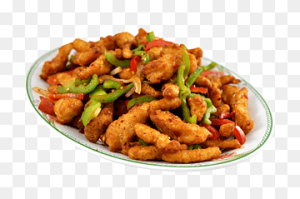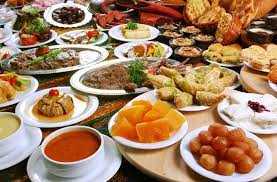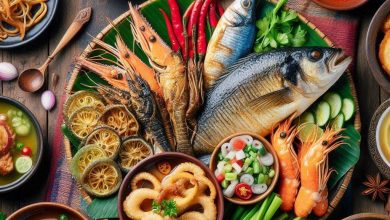A Culinary Tapestry: Exploring the Rich Flavors of Cambodian Cuisine
Cambodian Cuisine

Introduction:
Cambodia, which is tucked away in the center of Southeast Asia, has a remarkably rich and varied culinary heritage that is influenced by its location, history, and culture. Though sometimes eclipsed by its more well-known neighbors, Cambodian food is a culinary treasure awaiting exploration. This essay delves deeply into the fascinating realm of Cambodian cuisine, examining its distinctive dishes, cooking methods, cultural relevance, and changing gastronomic scene.
Historical and Cultural Influences:
The history of Cambodia, encompassing both the current problems and the historic glories of the Khmer Empire, is closely linked to the country’s gastronomic environment. With influences from China, Vietnam, and Thailand, among other places, Cambodian food has evolved into a unique cuisine with a balance of tastes, seasonal ingredients, and fragrant herbs.
Staples of Cambodian Cuisine:
In Cambodian culinary traditions, rice, a common ingredient in many Asian cuisines, has a particular significance. Rice is the main course of most meals in Cambodia, and it’s usually served with a variety of sauces, condiments, and side dishes. As a reflection of the accessibility of these foods in the area, fish, pig, and chicken are often utilized proteins.
Fish Amok: A Culinary Masterpiece:
Fish Amok, a fragrant and savory meal that captures the spirit of Khmer cuisine, is one of Cambodia’s culinary treasures. Fish Amok is a coconut milk-based curry that is steam-cooked with fish, fragrant herbs, and spices. The meal is generally served under banana leaves, which give it a distinct fragrance. This delicacy is a representation of the vast biodiversity of Cambodia as well as the culinary prowess of the nation.
Nom Banh Chok: Breakfast Delight:
Nom Banh Chok is a popular breakfast meal in Cambodia that reflects the affection the nation has for fresh rice noodles. This meal, which is served with a variety of crunchy raw veggies and a fish-based green curry sauce, is a lovely blend of flavors and textures that makes a savory start to the day.


Bai Sach Chrouk: Grilled Pork for Every Palate:
Grilled pork over rice, or Bai Sach Chrouk, is a common street food dish in Cambodia. Often marinated in a concoction of coconut milk, garlic, and soy sauce, the tender grilled pork produces a delightfully fragrant and aromatic dish. Bai Sach Chrouk, which is rich and simple Cambodian street cuisine, is a filling dish that is best enjoyed over rice with pickled veggies.
Prahok: A Unique Fermented Fish Paste:
A unique component of Cambodian cooking, phrak is a fermented fish paste that gives a lot of meals a rich, umami flavor. Prahok is an essential ingredient in many traditional Cambodian dishes, including the well-known Prahok Ktiss, a spicy dip prepared with minced pork, coconut milk, and a variety of herbs, even if some people may find its strong scent overpowering.
Street Food Culture:
The street food scene in Cambodia is thriving and deeply ingrained in daily life. A wide variety of vendors selling grilled meats, noodle meals, fresh fruit, and delicious sweets can be found throughout the busy markets. Cambodian street food experiences are not limited to the cuisine; they also include a vibrant environment and friendly local sellers.
Cultural Significance:
In Cambodia, food serves as more than just nourishment; it is a fundamental aspect of the national identity, representing customs, holidays, and shared ideals. Gathering around a table to celebrate life’s little and large occasions is a sign of hospitality and solidarity. Cambodian food is a vital part of culture, from religious events to family get-togethers.
Culinary Challenges and Innovations:
The food scene in Cambodia has had difficulties recently as a result of urbanization, shifting dietary habits, and changes in the country’s economy. On the other hand, creative methods to revive and improve Cambodian food are being combined with a rising effort to protect and promote traditional recipes. Chefs and food aficionados are experimenting with contemporary methods while maintaining the originality of Khmer cuisine.
Influences from the West and Globalization:
The gastronomic landscape of Cambodia is beginning to change as a result of globalization and influences from Western cuisines. A new wave of gourmet experiences that appeal to a wide and changing palate is being created by upscale restaurants in metropolitan hubs that combine native Cambodian products with cuisines from across the world.


Conclusion:
The rich culinary legacy and variety of Cambodian cuisine attest to the nation’s tenacity and cultural diversity. From upscale restaurants to lively street markets, Cambodia provides a culinary adventure that captures the essence of the country. There’s a fine line between honoring history and welcoming innovation as the food scene changes. Discovering Cambodian food is an expedition that reveals the layers of history, culture, and distinctive flavors that make it a hidden jewel in the realm of global gastronomy, whether you’re enjoying the famous Fish Amok or indulging in street-side treats.





